‘Bismarck’ Category
» posted on Tuesday, August 28th, 2012 by Linda Lou Burton
Bismarck’s Big Block
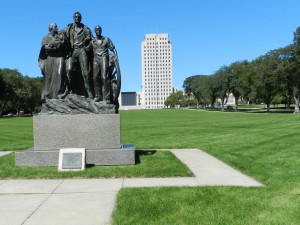 Linda Burton posting from Bismarck, North Dakota – If it’s Sunday you take a picnic and the family, or meet your friends for a game of touch football. If it’s a workday, you join your coworkers for a brisk hike around the grounds, your choice of trails; walk a mile or two during lunch. If it’s the dead of winter with snow on the ground, you might join 8,962 townspeople to make angels in the snow as you set a new Guinness World Record. You can do those things when you have large tree-lined open spaces that are designated for public use. And that’s what they have in Bismarck. They started out with 160 acres back in 1883, deeded to North Dakota Territory by the Northern Pacific Railroad. Today the property is still ample – 132 acres – and on it sits the North Dakota state capitol, along with the North Dakota Heritage Center, the State Office Building, the Department of Transportation, and the Governor’s Residence. With lots of space left over for parks, and trails, and fresh-cut grass. » read more
Linda Burton posting from Bismarck, North Dakota – If it’s Sunday you take a picnic and the family, or meet your friends for a game of touch football. If it’s a workday, you join your coworkers for a brisk hike around the grounds, your choice of trails; walk a mile or two during lunch. If it’s the dead of winter with snow on the ground, you might join 8,962 townspeople to make angels in the snow as you set a new Guinness World Record. You can do those things when you have large tree-lined open spaces that are designated for public use. And that’s what they have in Bismarck. They started out with 160 acres back in 1883, deeded to North Dakota Territory by the Northern Pacific Railroad. Today the property is still ample – 132 acres – and on it sits the North Dakota state capitol, along with the North Dakota Heritage Center, the State Office Building, the Department of Transportation, and the Governor’s Residence. With lots of space left over for parks, and trails, and fresh-cut grass. » read more
» posted on Monday, August 27th, 2012 by Linda Lou Burton
He Called Her Janey
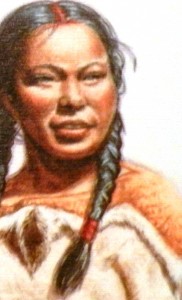 Linda Burton posting from Bismarck, North Dakota – Is it Sacajawea? Or Sacagawea? I’ve seen it spelled both ways as I have been bumping into Lewis and Clark of late. And now, here in Bismarck, the statue near the capitol honoring the “Bird Woman” has a spelling of “Sakakawea.”(pronounced Sa KAH- kah-we-a.) I was told at the Heritage Center that North Dakota chose this spelling and pronunciation because it more closely matches the Shoshone sound of her name. Yet, when I traveled north to the Lewis & Clark Interpretive Center in Washburn, North Dakota, I found exhibits there use the
Linda Burton posting from Bismarck, North Dakota – Is it Sacajawea? Or Sacagawea? I’ve seen it spelled both ways as I have been bumping into Lewis and Clark of late. And now, here in Bismarck, the statue near the capitol honoring the “Bird Woman” has a spelling of “Sakakawea.”(pronounced Sa KAH- kah-we-a.) I was told at the Heritage Center that North Dakota chose this spelling and pronunciation because it more closely matches the Shoshone sound of her name. Yet, when I traveled north to the Lewis & Clark Interpretive Center in Washburn, North Dakota, I found exhibits there use the  spelling of “Sacagawea.” The Bismarck statue, erected in 1910 by the Federated Clubwomen and the Schoolchildren of North Dakota, bestows great honor on the young woman; the plaque reads: The Shoshone Indian “Bird Woman” who in 1805 guided the Lewis and Clark Expedition from the Missouri River to the Yellowstone. The exhibit in Washburn, just completed this year, grants her a smaller role; presented in terms of “Legend” and “Fact,” it states she was not a guide, but an interpreter; and that William Clark, though fond of her, was not a romantic relationship. But, it is acknowledged, he called her Janey. » read more
spelling of “Sacagawea.” The Bismarck statue, erected in 1910 by the Federated Clubwomen and the Schoolchildren of North Dakota, bestows great honor on the young woman; the plaque reads: The Shoshone Indian “Bird Woman” who in 1805 guided the Lewis and Clark Expedition from the Missouri River to the Yellowstone. The exhibit in Washburn, just completed this year, grants her a smaller role; presented in terms of “Legend” and “Fact,” it states she was not a guide, but an interpreter; and that William Clark, though fond of her, was not a romantic relationship. But, it is acknowledged, he called her Janey. » read more
» posted on Sunday, August 26th, 2012 by Linda Lou Burton
Whimsy Does It
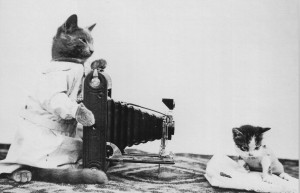 Linda Burton posting from Bismarck, North Dakota –A picture of a cat photographing a cat brought Nancy Hendrickson to my attention; the cats were wearing cute little hand-stitched clothes; the camera was vintage. Though published under the name P C Bill, the award-winning commercial photographer with the whimsical eye was Nancy Christenson Hendrickson (1886-1978, born and lived near Mandan, North Dakota). Not formally educated but
Linda Burton posting from Bismarck, North Dakota –A picture of a cat photographing a cat brought Nancy Hendrickson to my attention; the cats were wearing cute little hand-stitched clothes; the camera was vintage. Though published under the name P C Bill, the award-winning commercial photographer with the whimsical eye was Nancy Christenson Hendrickson (1886-1978, born and lived near Mandan, North Dakota). Not formally educated but 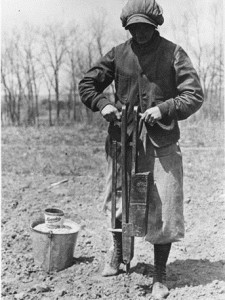 interested in just about everything, during her lifetime she was a rancher, farmer, gardener, seamstress and amateur meteorologist. The seventh child of pioneering Swedish homesteaders, she claimed a homestead of her own at an early age and built her own house. Widowed twice with no children of her own, she was a caretaker of family and counselor to neighbors; she collected coins and even had samples of sand from all 50 states! The photography career? Well, that began in 1902, when she bought a Kodak box camera for 35 cents. » read more
interested in just about everything, during her lifetime she was a rancher, farmer, gardener, seamstress and amateur meteorologist. The seventh child of pioneering Swedish homesteaders, she claimed a homestead of her own at an early age and built her own house. Widowed twice with no children of her own, she was a caretaker of family and counselor to neighbors; she collected coins and even had samples of sand from all 50 states! The photography career? Well, that began in 1902, when she bought a Kodak box camera for 35 cents. » read more
» posted on Saturday, August 25th, 2012 by Linda Lou Burton
Sit Down and Eat!
 Linda Burton posting from Bismarck, North Dakota – After the fifth person suggested I eat at Kroll’s, I decided to go for it. “Where can I find some German food?” was the question I’d been asking around this town with a German heritage and a German name. I checked Kroll’s website first, looking for their address, and soon fell into such a giggle fit I didn’t care if the food was good or not, I just wanted to be there. Kroll’s is a 50’s-style restaurant with locations in Bismarck, Mandan, Minot and Fargo and has been serving up German (and American) food since 1972, according to their online blurb. Go there for your Knoephla, they sell it by the bucketful (bring the bucket back for a refill), or your Fleischkeuchele; have a little Kuchen for dessert. But the menu isn’t what was making me laugh. It was Clara, and Carol, and Eileen, Kroll’s “girls” who will make you laugh too, just watch. http://www.sitdownandeat.com/flash/german.html
Linda Burton posting from Bismarck, North Dakota – After the fifth person suggested I eat at Kroll’s, I decided to go for it. “Where can I find some German food?” was the question I’d been asking around this town with a German heritage and a German name. I checked Kroll’s website first, looking for their address, and soon fell into such a giggle fit I didn’t care if the food was good or not, I just wanted to be there. Kroll’s is a 50’s-style restaurant with locations in Bismarck, Mandan, Minot and Fargo and has been serving up German (and American) food since 1972, according to their online blurb. Go there for your Knoephla, they sell it by the bucketful (bring the bucket back for a refill), or your Fleischkeuchele; have a little Kuchen for dessert. But the menu isn’t what was making me laugh. It was Clara, and Carol, and Eileen, Kroll’s “girls” who will make you laugh too, just watch. http://www.sitdownandeat.com/flash/german.html
And then, Sit Down And Eat! » read more
» posted on Thursday, August 23rd, 2012 by Linda Lou Burton
Good Things Come in Threes
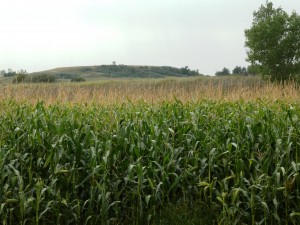 Linda Burton posting from Bismarck, North Dakota – A field of corn caught my eye, just outside the gates. It was framed against the backdrop of a gently rounded hill, the shape the same as the rounded earth houses I’d just been inside. I’m at Fort Abraham Lincoln State Park, on the edge of the Missouri River, where re-creations allow a glimpse of the Mandan Village that Lewis and Clark came upon in 1805. The rounded homes in On-A-Slant Village gather in a cluster, each facing the
Linda Burton posting from Bismarck, North Dakota – A field of corn caught my eye, just outside the gates. It was framed against the backdrop of a gently rounded hill, the shape the same as the rounded earth houses I’d just been inside. I’m at Fort Abraham Lincoln State Park, on the edge of the Missouri River, where re-creations allow a glimpse of the Mandan Village that Lewis and Clark came upon in 1805. The rounded homes in On-A-Slant Village gather in a cluster, each facing the 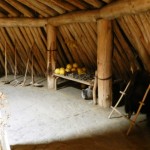 center; solid built; earth packed tightly against the weather and the wind. Inside, beds and benches show a daily way of life; a stone circle for the fire; animal skins for blanket warmth; clay pots, a rake, a hoe, a stack of squash in brilliant orange. These were farmers, who cultivated corn and squash and beans in gardens along the riverbanks. Their crops were bred to flourish here; the modern field corn I see today traces its roots to native stock; their legacy continues. » read more
center; solid built; earth packed tightly against the weather and the wind. Inside, beds and benches show a daily way of life; a stone circle for the fire; animal skins for blanket warmth; clay pots, a rake, a hoe, a stack of squash in brilliant orange. These were farmers, who cultivated corn and squash and beans in gardens along the riverbanks. Their crops were bred to flourish here; the modern field corn I see today traces its roots to native stock; their legacy continues. » read more
» posted on Wednesday, August 22nd, 2012 by Linda Lou Burton
Do You Like Spaghetti?
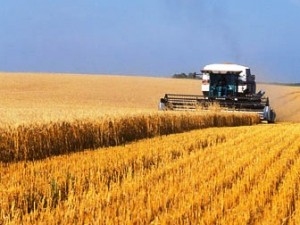 Linda Burton posting from Bismarck, North Dakota – Wherever you are, if you are eating spaghetti, you are likely eating something from North Dakota. That’s because spaghetti is made from durum wheat, and more than 70% of the durum wheat grown in the US is grown in North Dakota. That may not be all of North Dakota that is sitting in your pantry. More than 90% of all US flaxseed is grown in North Dakota, and more than 80% of all canola. Those last two may be on your shelf in the form of edible oil (did you know “canola” stands for Canadian oil, low acid?); both
Linda Burton posting from Bismarck, North Dakota – Wherever you are, if you are eating spaghetti, you are likely eating something from North Dakota. That’s because spaghetti is made from durum wheat, and more than 70% of the durum wheat grown in the US is grown in North Dakota. That may not be all of North Dakota that is sitting in your pantry. More than 90% of all US flaxseed is grown in North Dakota, and more than 80% of all canola. Those last two may be on your shelf in the form of edible oil (did you know “canola” stands for Canadian oil, low acid?); both  have more uses than you can shake a stick at – oils and nutritional supplements for consumption by humans and by livestock; biodiesel fuel; as an ingredient in wood-finishing products. Various parts of the plants are used to make fabric, dye, paper, medicines, fishing nets, hair gels, cloth, rope and soap! » read more
have more uses than you can shake a stick at – oils and nutritional supplements for consumption by humans and by livestock; biodiesel fuel; as an ingredient in wood-finishing products. Various parts of the plants are used to make fabric, dye, paper, medicines, fishing nets, hair gels, cloth, rope and soap! » read more
» posted on Tuesday, August 21st, 2012 by Linda Lou Burton
Enticements
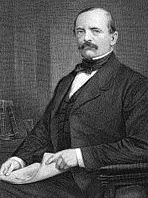 Linda Burton posting from Bismarck, North Dakota – I got a mouthful of information from City Portrait on Bismarck’s official website. It says “On July 17, 1873, Bismarck was named in honor of Germany’s “Iron Chancellor” Prince Baron Otto Eduard Leopold Von Bismarck-Schoenhausen, a famous German statesman from Prussia, credited with the creation of the German Empire and serving as her first chancellor.” I wanted to make the connection between Bismarck’s name and the area around Bismarck known as “the German-Russian Triangle.” It’s also called the “Sauerkraut Triangle,” and is one of the most homogeneous ethnic German-Russian enclaves in existence today; in six North Dakota counties at least 75 percent of the people claim German ancestry. So, why was Bismarck named Bismarck? It’s a story of enticement, and railroads. » read more
Linda Burton posting from Bismarck, North Dakota – I got a mouthful of information from City Portrait on Bismarck’s official website. It says “On July 17, 1873, Bismarck was named in honor of Germany’s “Iron Chancellor” Prince Baron Otto Eduard Leopold Von Bismarck-Schoenhausen, a famous German statesman from Prussia, credited with the creation of the German Empire and serving as her first chancellor.” I wanted to make the connection between Bismarck’s name and the area around Bismarck known as “the German-Russian Triangle.” It’s also called the “Sauerkraut Triangle,” and is one of the most homogeneous ethnic German-Russian enclaves in existence today; in six North Dakota counties at least 75 percent of the people claim German ancestry. So, why was Bismarck named Bismarck? It’s a story of enticement, and railroads. » read more
» posted on Monday, August 20th, 2012 by Linda Lou Burton
Beyond Numbers
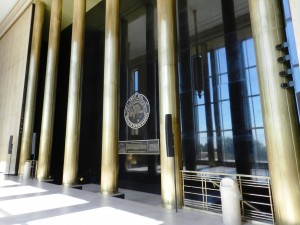 Linda Burton posting from Bismarck, North Dakota – “Over 80 percent of this capitol building is usable space,” the tour guide said. “As compared to Minnesota, say, where they can use only 29 percent. They have that big dome.” The guide has more numbers and comparisons; the North Dakota capitol cost $2 million to build in 1934, the Nebraska capitol, also a highrise, cost $11 million, she says. That’s $.46 per square foot vs $1.10. Frugality was a major consideration when building the North Dakota capitol; this is a state that simply doesn’t spend what it doesn’t have. After the old capitol burned in 1930, they sold 160 acres of land and used insurance money from the burned building to pay for the new capitol. Workers threatened a strike part-way
Linda Burton posting from Bismarck, North Dakota – “Over 80 percent of this capitol building is usable space,” the tour guide said. “As compared to Minnesota, say, where they can use only 29 percent. They have that big dome.” The guide has more numbers and comparisons; the North Dakota capitol cost $2 million to build in 1934, the Nebraska capitol, also a highrise, cost $11 million, she says. That’s $.46 per square foot vs $1.10. Frugality was a major consideration when building the North Dakota capitol; this is a state that simply doesn’t spend what it doesn’t have. After the old capitol burned in 1930, they sold 160 acres of land and used insurance money from the burned building to pay for the new capitol. Workers threatened a strike part-way 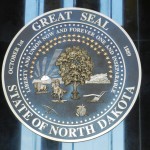 through; laborers asked for a raise from 30 cents an hour to 50. The governor called out the National Guard to protect the partially constructed building; workers were granted a 10 cent raise. Work continued, and the building was first occupied in January 1935. On time, and on budget. One thing I noticed right away; planning may have focused on frugal, and the outside may appear plain, but the building is impressive in its indoor elegance, and its streamlined efficiency. » read more
through; laborers asked for a raise from 30 cents an hour to 50. The governor called out the National Guard to protect the partially constructed building; workers were granted a 10 cent raise. Work continued, and the building was first occupied in January 1935. On time, and on budget. One thing I noticed right away; planning may have focused on frugal, and the outside may appear plain, but the building is impressive in its indoor elegance, and its streamlined efficiency. » read more
» posted on Sunday, August 19th, 2012 by Linda Lou Burton
Lay of the Land
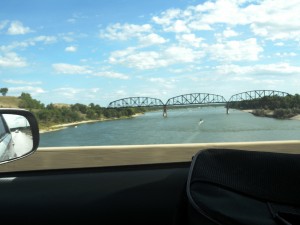 Linda Burton posting from Bismarck, North Dakota – I vaguely remember crossing the Missouri River coming into town on Friday; the GPS was on the blink so I was paying more attention to road signs than anything else. I also vaguely remember crossing a Time Zone advisory; it happened just a few miles before I got to town. For a reason I don’t know yet, half of North Dakota is on Mountain Time; the other half on Central. So, to orient myself, I’m on Central Time now, I’m east of the Missouri River; and I’m in the prairie. It is flat here. From the top of the freeway overpass I can see a hundred miles in every direction. Flat. Today I’m studying the map I got
Linda Burton posting from Bismarck, North Dakota – I vaguely remember crossing the Missouri River coming into town on Friday; the GPS was on the blink so I was paying more attention to road signs than anything else. I also vaguely remember crossing a Time Zone advisory; it happened just a few miles before I got to town. For a reason I don’t know yet, half of North Dakota is on Mountain Time; the other half on Central. So, to orient myself, I’m on Central Time now, I’m east of the Missouri River; and I’m in the prairie. It is flat here. From the top of the freeway overpass I can see a hundred miles in every direction. Flat. Today I’m studying the map I got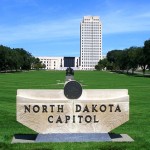 from the front desk. The weather report I hear on TV refers to Bismarck-Mandan; studying the map I can see why. Bismarck is in Burleigh County; Mandan is just across the river in Morton County to the west. But for purposes of weather, and entertainment, they seem to function as one and the same. The State Capitol (in Bismarck) is only blocks from I-94, take State Street south, turn right. It’s the first high-rise capitol on the Journey, 19 stories rising up above the plains. The Heritage Center, North Dakota’s state museum, is right beside. I see that the Bismarck Expressway circles south below the main part of town and over into Mandan; another bridge across the Missouri. » read more
from the front desk. The weather report I hear on TV refers to Bismarck-Mandan; studying the map I can see why. Bismarck is in Burleigh County; Mandan is just across the river in Morton County to the west. But for purposes of weather, and entertainment, they seem to function as one and the same. The State Capitol (in Bismarck) is only blocks from I-94, take State Street south, turn right. It’s the first high-rise capitol on the Journey, 19 stories rising up above the plains. The Heritage Center, North Dakota’s state museum, is right beside. I see that the Bismarck Expressway circles south below the main part of town and over into Mandan; another bridge across the Missouri. » read more
» posted on Saturday, August 18th, 2012 by Linda Lou Burton
Sky High
 Linda Burton posting from Bismarck, North Dakota – “Everything’s high in Bismarck,” was the answer I got. “Just wait till you see the price of orange juice when you go to the store.” I’d anticipated summer tourist room rates in Honolulu and Juneau, but Bismarck rates were a surprise. I was too tired last night to look elsewhere; I only removed from the car the items that would get us through the night. My room was sparkling clean and modern, tastefully furnished, overlooking a pretty rock garden and a row of trees between the building and the street. But it was not much bigger than its double bed; there was no work space for my computer; how could I live in such a tight space for two weeks? The manager brought a table and a chair and an extension cord; I thanked him yet began an online search for a bigger place, at a better rate. I found no better deal, but I found the answer to my question “Why so high?” It’s Williston, North Dakota, some 200 miles northwest of here. Williston is called Kuwait on the Prairie now, where 100 new oil wells are drilled every day by some 150 oil companies that have come here since 2006. Sister, there’s an oil boom going on. » read more
Linda Burton posting from Bismarck, North Dakota – “Everything’s high in Bismarck,” was the answer I got. “Just wait till you see the price of orange juice when you go to the store.” I’d anticipated summer tourist room rates in Honolulu and Juneau, but Bismarck rates were a surprise. I was too tired last night to look elsewhere; I only removed from the car the items that would get us through the night. My room was sparkling clean and modern, tastefully furnished, overlooking a pretty rock garden and a row of trees between the building and the street. But it was not much bigger than its double bed; there was no work space for my computer; how could I live in such a tight space for two weeks? The manager brought a table and a chair and an extension cord; I thanked him yet began an online search for a bigger place, at a better rate. I found no better deal, but I found the answer to my question “Why so high?” It’s Williston, North Dakota, some 200 miles northwest of here. Williston is called Kuwait on the Prairie now, where 100 new oil wells are drilled every day by some 150 oil companies that have come here since 2006. Sister, there’s an oil boom going on. » read more
